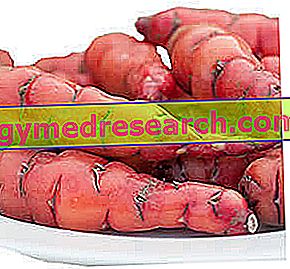Generality
The American potato or batata is NOT properly a tuber (like the common potato), but a tuberous (or tuberized) root. In addition to Italy, where we also know it as a sweet potato, in many other countries the batata is erroneously considered a potato variety (not surprisingly, in English it is also known as sweet potato ).

The American potato is commonly called sweet potato thanks to the high content of simple carbohydrates which give it its typically sweetened flavor. From the nutritional point of view, it mainly supplies carbohydrates (mainly complex), has an excellent amount of fiber and "amazes" for the high concentration of retinol equivalents (vit. A), slightly lower than that of carrots.
The American potato belongs to the family of Convolvulaceae, Genus Ipomea, Species batatas ; the binomial nomenclature of the American potato is Ipomoea batatas, hence the vulgar name "batata".
There are about 50 genus of plants with tuberous roots similar to the American potato and more than 1, 000 different species, but the only one that has been significantly exploited for agriculture destined for human nutrition is Ipomea batatas . Some edible species are exploited exclusively at the "local" level, but there are many other poisonous for the human being.
It is interesting to note that the botanical order of the American potato (Solanales) is the same as for tomatoes, aubergines, peppers, common potatoes etc., but the family is completely different and common to ornamental-floral plants such as: Morning Glory ( translation from English Morning Glories ).
Description
The plant is herbaceous and perennial; it has heart-shaped lobed or palmate leaves and the flowers are alternate, of medium size and with the petals partially fused together. The tuberous root, or the edible part, is large, slightly tapered, with a smooth skin and a color that varies between yellow, orange, red, brown, purple and beige. The pulp of the American potato fades between beige, white, red, pink, purple, yellow, orange and purple. The white or yellow ones (the most widespread in Italy) are less sweet and succulent than the others.
Distribution and cultivation
The oldest finds showing American potato consumption (probably after harvesting) have been identified in Peru and date back to 8000 BC. On the contrary, it seems that the first cultivations took place in central-southern America only in 3, 000 BC. it is conceivable that the area of origin of the American potato is between the Yucatan peninsula (Mexico) and the mouth of the Orinoco river (Venezuela).
Today, thanks to import-export, the American potato is cultivated in all the temperate zones of the planet, wherever there is a sufficient amount of water for development and maturation. In all likelihood, the first NOT native areas that hosted it are North America, Polynesia, Japan and later the whole of continental Asia.
According to FAO ( Food and Agriculture Organization ) statistics, American potato production in 2004 was 127 million tons, most of which in China (105 million tonnes) where it is also used for food of cattle.
 | |||||||||||||||||||||||||||||||||||||||||||||||||||||||||||||||||||||||||||||||||||||||||||||||||||||||||||||||||||||||||||||||||||||||
Nutritional values (per 100 g of edible portion)
| |||||||||||||||||||||||||||||||||||||||||||||||||||||||||||||||||||||||||||||||||||||||||||||||||||||||||||||||||||||||||||||||||||||||
The American potato DOES NOT tolerate harsh or dry climates and requires average temperatures of 24 ° C, a lot of sun and warm nights. Furthermore, irrigation must not cause stagnation to avoid the tuber's rotting. The favorite soil of the plant is: draining, light and medium-textured with a pH of 4.5-7; massive fertilization is not necessary. The propagation of the American potato occurs by stem or cutting or adventitious roots; the seeds are used only for reproduction between plants. Cultivation times are around 2-9 months, including early and late varieties. Usually, it is not necessary to use pesticides and the average yield is about 13.2 tons per hectare.
The American potato played an essential role in the North American diet (especially in the south-east) until the mid-twentieth century AD, when, with the economic recovery, consumption was reduced considerably. In these areas, the American potato was consumed both fresh and dehydrated (preserved).
Nutritional characteristics
The American potato is a food belonging to the VI group of foods. It contains mainly complex carbohydrates but the portion of simple sugars is still relevant; the glycemic index of the American potato is quite high and this makes it a food not very suitable for the diet of the diabetic and the obese. Proteins are of little importance and even less fat. The fibers seem rather abundant and this aspect makes the sweet potato a suitable product for those suffering from constipation. As for mineral salts, the American potato is rich in potassium and manganese; with regard to vitamins, there is a good supply of pyridoxine (vit. B6) and an extraordinary content of vit. A (RAE).
According to estimates by the Center for Science in the Public Interest, the nutritional value of the American potato is a good 100 points higher than that of the common potato. Compared to the latter, the sweet potato has a much higher content of retinol equivalents, especially β-carotene . A 2012 study carried out in Uganda, which involved around 10, 000 families, showed that: " ONLY 10% of subjects who eat dark orange American potatoes suffer from vitamin deficiencies of retinol equivalent, while as many as 50% of those who prefer beige or straw yellow American potatoes show significant hypovitaminosis "; this is justifiable by the greater β-carotene intake of dark orange American potatoes compared to the lighter ones.
Sweet potatoes cake
X Problems with video playback? Reload from YouTube Go to Video Page Go to Video Recipes Section Watch the video on youtubeBibliography:
- Reference site - en.wikipedia.org/wiki/Sweet_potato
- Coghlan, Andy (17 August 2012) Nutrient-boosted foods protect against blindness New Scientist, Health, Retrieved 20 August 2012.



